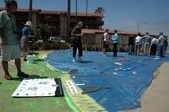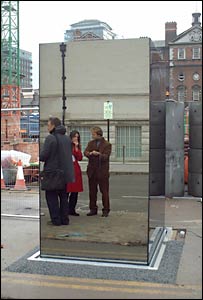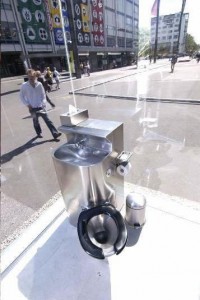Art and Toilets
 The early collaboration of PHLUSH with Portland’s City Repair Project brought creative types in touch with specialists in city bureaus and facilitated early progress. In 2006, PHLUSH Volunteer and City Repair liaison Sally Nobel organized an event to design and build the attention-getting PHLUSH kiosk as a part of the annual Village Building Convergence.
The next year, as part of VBC7, Nobel organized community design workshops downtown Portland and in Old Town Chinatown. These meetings provided the input into the ground breaking conceptual designs of Mark Lakeman, who founded City Repair and heads Communitecture, Inc.
The toilets envisioned are safe, accessible and welcoming. They include a portable-sanitation-unit-in-disguise, a parking-lot-restroom, and the sidewalk-kiosk-with-attendant shown here, which inspired the Portland Loo.
Great comtemporary restrooms incorporate art, culture and information into the design.
People enjoy interesting and attractive toilets that make them think. As the following remarkable examples demonstrate, restrooms and areas around them where people gather can be dramatically used to inform, educate, inspire and amuse.
An interpretive map to guide visitors in underwater ecology.
To complement her award-winning Kellogg Park South Comfort Station, San Diego restroom designer Mary Coakley led a community effort to install a major work of art + information on the oceanfront site. Experts from the nearby Scripps Institution of Oceanography and Birch Aquarium collaborated with community members to design and raise funding for the Interpretative Map of the La Jolla Shores Underwater Park and Ecological Reserve.
The early collaboration of PHLUSH with Portland’s City Repair Project brought creative types in touch with specialists in city bureaus and facilitated early progress. In 2006, PHLUSH Volunteer and City Repair liaison Sally Nobel organized an event to design and build the attention-getting PHLUSH kiosk as a part of the annual Village Building Convergence.
The next year, as part of VBC7, Nobel organized community design workshops downtown Portland and in Old Town Chinatown. These meetings provided the input into the ground breaking conceptual designs of Mark Lakeman, who founded City Repair and heads Communitecture, Inc.
The toilets envisioned are safe, accessible and welcoming. They include a portable-sanitation-unit-in-disguise, a parking-lot-restroom, and the sidewalk-kiosk-with-attendant shown here, which inspired the Portland Loo.
Great comtemporary restrooms incorporate art, culture and information into the design.
People enjoy interesting and attractive toilets that make them think. As the following remarkable examples demonstrate, restrooms and areas around them where people gather can be dramatically used to inform, educate, inspire and amuse.
An interpretive map to guide visitors in underwater ecology.
To complement her award-winning Kellogg Park South Comfort Station, San Diego restroom designer Mary Coakley led a community effort to install a major work of art + information on the oceanfront site. Experts from the nearby Scripps Institution of Oceanography and Birch Aquarium collaborated with community members to design and raise funding for the Interpretative Map of the La Jolla Shores Underwater Park and Ecological Reserve.

 The Kawakawa Public Toilets in Northland, New Zealand, have become a significant tourist draw and leveraged the economic development of a small rural town. Designed by renowned Austrian artist Frederich Hunderwasser, the building is a work of art, from the grass roof, to gold balls, ceramic tiles, bottle glass windows, mosaic tiling, copper handwork, cobblestone flooring, individual sculptures and a living tree integrated into the design structure. In 1998 the Kawakawa Community Board in rural New Zealand needed to upgrade their 40 year-old public toilets. The artist involved individual community members in the design and construction and the community contributed the labor and materials. Students at a local school prepared the tiles and bricks were recycled from a former Bank of New Zealand building. The one of a kind Kwawkawa toilet complex has spurred economic development by attracting thousands of visitors every year.
The Kawakawa Public Toilets in Northland, New Zealand, have become a significant tourist draw and leveraged the economic development of a small rural town. Designed by renowned Austrian artist Frederich Hunderwasser, the building is a work of art, from the grass roof, to gold balls, ceramic tiles, bottle glass windows, mosaic tiling, copper handwork, cobblestone flooring, individual sculptures and a living tree integrated into the design structure. In 1998 the Kawakawa Community Board in rural New Zealand needed to upgrade their 40 year-old public toilets. The artist involved individual community members in the design and construction and the community contributed the labor and materials. Students at a local school prepared the tiles and bricks were recycled from a former Bank of New Zealand building. The one of a kind Kwawkawa toilet complex has spurred economic development by attracting thousands of visitors every year.
Witty fun and optical illusion.
The Denver Zoo uses restroom areas to educate visitors through bold graphics on the stall doors and the floor. Designed by the Boulder-based firm ECOS Communications, the artwork is witty and engaging. As one approaches the restrooms, a linoleum stream of water populated with alligators and fish appears to flow out from under the restroom door. Kids entering the restroom can keep their feet out of the “water” by negotiation a line of “rocks.” Once inside the restroom visitors are greeted by a recorded soundtrack with information ranging from details about lobster urination to the zoo’s efforts in water conservation.
The public toilet as conceptual art.
 Italian Artist Monica Bonvinici‘s acclaimed work entitled “Don’t Miss a Sec” is a toilet in a glass pavilion erected on the sidewalk near a construction site opposite London’s Tate Gallery.
Italian Artist Monica Bonvinici‘s acclaimed work entitled “Don’t Miss a Sec” is a toilet in a glass pavilion erected on the sidewalk near a construction site opposite London’s Tate Gallery.

Made from stainless steel and reflective glass, the temporary installation served construction workers who spent a year transforming the London Institute Millbank into the Chelsea College of Art and Design. The working toilet had a high quality stainless steel unit, designed for prisons, with a commode and a wash basin. From inside users had a panoramic view of the site. Pedestrians passing by saw only their reflection and that of surrounding urban landscape. Bonvinici’s innovative design has been exhibited in other locations, including Basel, Switzerland.

